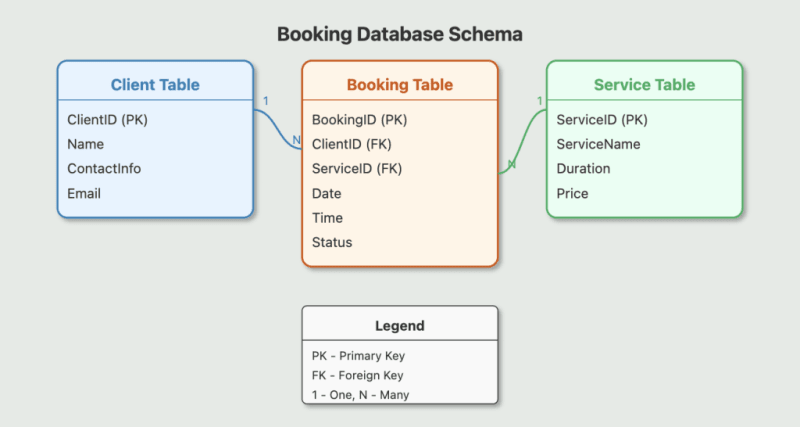How to Create a Booking Database
A booking database is essential for businesses that rely on scheduling appointments, managing reservations, or organizing events.
It keeps track of client details, booking times, and service histories, serving as the central source of truth for managing bookings and customer interactions.
If you're unsure where to begin, this guide will walk you through the process of creating an efficient booking database, helping you avoid issues like double bookings and missed appointments.
Let's dive in and learn how to develop a booking database.
Why Build a Booking Database?
A good booking database is key to smooth operations. It helps you:
- Monitor appointment schedules: Ensure that all bookings are tracked, avoiding conflicts or double bookings.
- Follow up on reservations: Keep a history of all bookings to easily manage follow-ups and client communications.
- Handle cancellations and rescheduling: Efficiently manage changes in appointments to maintain customer satisfaction.
- Ensure timely service delivery: Keep track of client preferences and special requests to provide a personalized experience.
Having all your booking information in one place means everyone's on the same page. This lets you make smarter choices about scheduling and managing your time and resources effectively.
What Is a Booking Database?
A booking database stores detailed information or attributes about your appointments, such as client names, contact details, booking dates, service types, and payment status.
Depending on your business, you might also track attributes like client preferences, special requirements (e.g., "wheelchair accessible," "allergy-friendly"), or specific conditions (e.g., "VIP client," "recurring booking").
Let's say you're in charge of managing appointments for a service-based business. Your main computer system might handle the basics, like who your clients are and when they’ve booked. But it might not be great at keeping track of all the finer details like service preferences or client history.
That's where a proper booking database comes in handy. It's like a one-stop shop for everything about your appointments and bookings. You can search it easily, and it keeps all the important info in one place. This makes it much easier to keep an eye on how things are going with all your bookings.
Why Spreadsheets Fall Short for Booking Databases
Let's face it, many businesses start out tracking their bookings in Excel or Google Sheets. It seems easy at first, especially when you're just starting out. But as your business grows, these spreadsheets can cause some real headaches:
- Version Chaos: Before you know it, everyone's got their own copy. You end up with a mess of files like "BookingList_LATEST," "Appointments Database – Updated," "Old Booking List – IGNORE," and so on. Who knows which one's right?
- No Clear History: Without a proper system, it's hard to keep track of who changed what and when. If the person in charge of updates leaves, you might be left scratching your head about why certain changes were made.
- Data Gets Messy: People start adding their own notes, highlighting things, and making manual tweaks. Soon enough, you've got a rainbow of colors and comments that don't make sense to anyone else. For example, someone might mark a booking in red to show it’s been canceled, but others might miss it or misunderstand.
Using spreadsheets for your booking info goes against the whole point of having one trustworthy source of data. Instead of smoothly managing your appointments, you end up playing detective with a bunch of conflicting spreadsheets.
Building a real booking database with a proper tool can solve these problems. It gives you one central place for all your booking info that everyone can rely on. This ensures smoother operations, better client management, and a more efficient booking system.
How to Create a Booking Database in 3 Steps

Let’s be real—if you’re running a business, you probably don’t have time to become a database expert. Normally, you’d need to fully understand concepts like SQL and how to build user interfaces. That’s a lot to ask when you’re busy keeping your business running smoothly.
This is why many small businesses put off creating a proper booking database. It just seems too complicated and time-consuming.
But here’s where tools like Five come in handy. It’s an online database builder that makes creating a booking database much simpler.
Now, I won’t lie—it’s not as easy as snapping your fingers. But it’s a whole lot easier than spending weeks learning to code from scratch.
With Five, you can:
- Quickly set up your booking database: Get a user-friendly interface without any extra work. It’s easy to import your existing booking data from Excel or other spreadsheets, so you don’t have to start from scratch.
- Add custom features: Create detailed reports about your bookings, client interactions, and resource allocation. Set up charts to help you visualize your data at a glance. One of the handiest features is the ability to set up alerts that notify you when appointments need to be confirmed, rescheduled, or followed up on, helping you stay on top of your booking needs.
- Access it from any device: Whether you’re at your desk or on the go, you can always check and manage your booking information securely.
Want to give it a shot? Here’s how to get started:
- Sign up for free: Five offers a free trial to help you get started.
- Create your own booking database: You can use a template or start from scratch—Five makes it easy.
- Add forms: Collect essential information like client details, booking times, and service requirements.
- Set up logins for your team: Ensure secure access for staff, and even set up logins for clients if needed.
Create a Booking Database
Rapidly build and deploy your database today
Step 1: What You Need to Know About Your Bookings
First things first, think about what information you really need to manage your bookings effectively. What matters to your business? What do your team and clients care about? You want your booking database to be the go-to place for all this information, so make it as complete as you can.
Here’s a list of things you might want to keep track of:
- Client ID and Name
- Service Type
- Booking Date and Time
- Special Requirements
- Contact Information
- Booking Status (Confirmed, Pending, Canceled)
- Payment Status
- Follow-up Notes
Step 2: Think About How You Manage Bookings
Your booking database isn’t just a list—it should help you manage your appointments day-to-day. Think about things like:
- Scheduling: Keep track of appointment dates, times, and any conflicts that need resolving.
- Client Communication: Note down any special requirements, changes, or follow-ups needed.
- Payment Tracking: Record when payments are due, when they’re received, and any issues that come up.
- Service Quality: Keep notes on client feedback, service delivery, and how well appointments went.
The more information you keep, the more useful your database will be. For example, if you want to see which types of bookings are the most profitable or which clients require the most attention, you’ll need to have been recording that information all along.
Remember, a good booking database grows with your business. Start with the basics, and you can always add more detail as you go along.
Step 3: Creating Your Booking Database
With your list of booking attributes and additional information ready, it’s time to move all of this into a proper database.
To do so, sign up for Five, an online database builder that comes with a simple point-and-click interface for creating relational databases.
Follow our video tutorial to build your database tables, forms, and reports, and start managing your bookings efficiently.
https://www.youtube.com/watch?list=PLerqEA4wsHa2vY5vW3fK1Nkl4Npxn5MKQ&v=jcRAhyw9rmI
The Booking Database Schema
Here’s the database schema for your application:
- Booking Table: At the core of the database, this table stores information about bookings and their attributes.
- Client Table: This table helps store client details, making it easier to organize and retrieve client information.
- Service Table: A critical component of the schema, this table links services to bookings and allows you to manage service-specific details.
Each table holds specific information, such as booking details, client contact information, and service types, ensuring a comprehensive and organized structure. The relationships between these tables facilitate efficient booking management.
Get Started with Five Today
To build your booking database with Five, sign up for free access and start the process. If you need assistance, visit our forum to get help from our application development experts as you add more features to your database application.
By following the steps mentioned above, you can create robust and scalable booking software tailored to your needs, all while using the tools provided inside of Five.




















